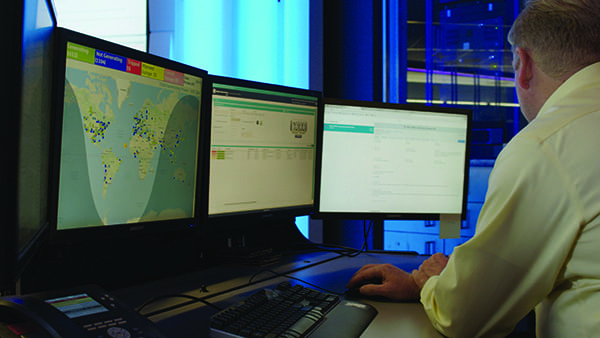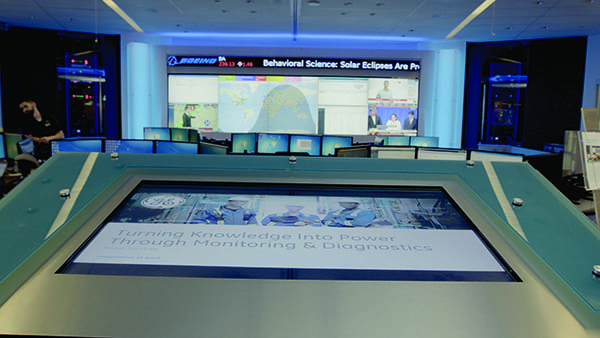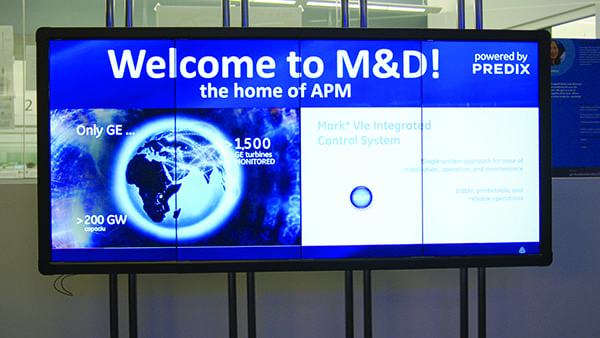An Inside Look at Digital Transformation: GE Power's Lessons Learned
GE has operated its monitoring and diagnostics center for nearly two decades, examining the performance and health of customers’ power plants and other generating assets around the world. Understanding some of its lessons learned over the years could help others develop a strategy and path forward for capturing value from digital projects.
Danielle finishes her first cup of coffee during her morning shift at GE’s Monitoring and Diagnostics (M&D) Center in Atlanta (Figure 1) as an alert pops up on her computer screen. Inside the center, a large, darkened room not unlike the studio of a major broadcast network fitted with rows and rows of glowing monitors, she examines the notification.
 |
| 1. GE’s Monitoring and Diagnostics (M&D) Center. Located in Atlanta, Georgia, the M&D center allows experts to evaluate the operation of customers’ assets worldwide. Courtesy: GE Power |
With the click of a button, she reviews several multicolored charts of data diagnosing a potential mechanical issue at a power plant thousands of miles away in Indonesia. Scanning the real-time readout of sensor data from the plant, Danielle decides to dispatch the case to another engineer with greater domain expertise in the specific gas turbine failure mode the alert indicates as the source of the fault. With a click, the case has been transmitted to this tier-two engineer for deeper analysis and consultation on the apparent issue, only minutes after the first alert.
Across the world in Indonesia, the customer’s engineering and operations teams at the plant received the same alert and are able to watch the diagnosis in real time, ready to spring into action to execute a recommended solution. At the same time, the power producer has already dispatched a startup routine to another asset to prepare to meet the company’s supply commitments to the grid and avoid any costly shortage penalties. Throughout the country, the power grid and supply remains stable as millions of people carry on their lives and daily routines without disruption.
Digital Monitoring Center
Sound futuristic? This scenario happens dozens of times every day at GE’s M&D center as the company’s largest thermal generation monitoring center increasingly turns to the next-generation digital solutions to support its operational backbone. The center oversees thousands of power plants and generation assets around the world (Figure 2), ensuring the reliable production of electricity for nearly 400 million people.
 |
| 2. Connected to the world. Workers at the M&D center oversee thousands of power plants and generation assets around the globe. Courtesy: GE Power |
GE has operated the center for nearly two decades, monitoring the performance and health of its customers’ assets and power plants. However, in the last year, the company began using the latest digital software solutions to augment the hardware and services engineering expertise deployed to address its services and maintenance cases.
Power producers and utilities around the world grapple with today’s volatile and competitive landscapes influenced by the rise of variable renewable energy sources, policy and regulation, demand-side innovation, and the rise of new technologies, such as electric vehicles, smart meters, and microgrids. Reductions in operations and maintenance spending, and more efficient deployment of the assets and the service teams that manage them, can make the difference between power sector leaders and laggards.
The upside and benefits for businesses in the electricity industry that properly capitalize and capture the value of digital technology are tremendous. In a 2017 report focused exclusively on digital’s impact on the electricity industry, the International Energy Agency describes the technology’s ability to “identify who needs energy and deliver it at the right time, in the right place and at the lowest cost. But getting everything right will not be easy.” The same report calculates the value of digitalization in the power industry to be $80 billion, or 5% of total annual power generation costs.
Since 2012, GE has focused on its journey to become the world’s premier digital industrial company to help customers capture that very value. More than 70 global power producers and utilities have started their digital strategy to do so, and many see digitally enabled monitoring as a first step to seizing the business value of digitalization.
In 2017, GE migrated the M&D center onto the company’s digital platform for the industrial internet—Predix—as well as its Asset Performance Management (APM) software, the same software it delivers to customers who purchase a subscription. The benefits of adding digital solutions to a current asset or plant monitoring program for customers include increases in total plant availability, reliability, and profitability, including richer alerts and monitoring through the use of cloud-based analytics and real-time sensor monitoring and analysis. GE itself benefits from using its solutions in-house to provide faster and more efficient service to customers in a seamless cloud-based digital environment (Figure 3).
 |
| 3. Real-time solutions. When an alarm is received, experts respond immediately to evaluate the problem and develop a plan of action. Courtesy: GE Power |
Lessons Learned from Digital Transformation
Despite enormous upside potential and opportunity, digital projects involve steep learning curves, requiring attention to detail, business leadership, and great focus to navigate a complex and sometimes difficult process. By learning from the best practices of other organizations and companies as they undergo digital projects, the strategy and path forward for new adopters to capture digital value becomes clearer and more defined.
More than a year into the project, here are some of the best practices and learnings from GE’s engineers and experts, implementing its own digital program.
Culture Change Is Imperative.Through the use of people, processes, and technologies, digitalization first and foremost requires culture change and evolution. Without a change to the culture of an organization, leadership, and even individual teams, digital initiatives are doomed to fail. According to Forbes, 84% of digital transformation projects undertaken by Fortune 500 companies fail or are likely to fail. An International Data Corp. (IDC) report claims that “70% of siloed digital transformation initiatives will ultimately fail because of insufficient collaboration, integration, sourcing, or project management.” Culture and communication can be the difference between success and failure of digitalization in organizations. Within GE, one of the biggest challenges throughout the migration of its monitoring capabilities was internal user adoption, that is, ensuring employees understood the benefits of the new software and supported the migration from legacy systems.
Employee Aptitude and Training Is Critical. Successfully implementing digital initiatives required a precise blend of the right talent—both new and current employees—and skills. To increase adoption and advocacy for change initiatives, it is imperative to engage the optimal blend of functional and experimental talent and skills in organizations. Current employees can bring a vast array of institutional and technical knowledge to inform how digital technology can be used most effectively, while technical and software talent are essential to executing digital deployments. New employees can see an organization’s opportunities with fresh eyes and actively promote conversations that create new and innovative solutions.
Sound Foundational Investments Are Required. To ensure a digital solution is successful, investments must also be made in foundational elements such as data quality, data analytics, asset models, and IT infrastructure to ensure the system meets the expectations of its users.
Collaboration Is Key. Allowing teams and business units within a company to co-innovate, learn, and share their knowledge leads to improved outcomes. Encourage innovation efforts that involve everyone in the value chain, including customers. Creative processes, such as hackathons, can provide additional insights.
Enterprise-Wide Engagement Provides Benefits. Increased operational efficiency provided by digital solutions allows customer service to achieve greater speed and clarity inside an organization or team, but both people and processes need to be adjusted to capture and utilize these savings. Additional training and investment in skills training will allow employees to maximize usage of digital tools, while old processes and workflows should adapt to capture time savings provided by using new technologies. In GE’s experience, taking advantage of the scale of cloud-based technologies provided significant cost and productivity benefits.
Digital Strategies Add Investor Value. According to investment banking firm Goldman Sachs, companies—including utilities—with a comprehensive digital strategy command a higher market valuation from investors, while at the same time increasing human capital through education and digital skills training. Digitalization can benefit an organization through increased shareholder and employee loyalty and advocacy, as long as the program includes opportunities for current members to understand and learn the skills necessary to participate.
Knowledge Retention Is Improved. Digital technologies enhance your workforce by enabling both knowledge capture and transfer. According to the World Economic Forum, one out of four electricity industry workers will retire in the next five years. As these experienced employees depart, they take with them decades of technical and domain expertise to the organization’s detriment. Unless a digital technology can begin to retain and transfer this knowledge to newer workforce members, it could be lost forever. By upskilling current employees and attracting new talent, organizations can develop an increasingly innovative culture that incubates lean thinking, agile collaboration, and faster process and system improvements. In a survey of hundreds of power and utility executives at GE’s Minds + Machines digital event in 2017, more than 60% of respondents viewed digital technology as vital or very important to their overall business strategy, yet many of them viewed the lack of an innovative culture as the single most important challenge to their digital efforts.
Access to Information Is Enhanced. Through adopting digital technologies as part of an M&D program, all relevant experts across your organization have access to a single view of asset health, maintenance, and engineering strategy, increasing internal partnership and efficiency. By using this access, teams across the product or asset lifecycle benefit from increased transparency and access to data for decision-making. Beyond a specific power plant or single asset, fleet-wide decision-making becomes more efficient. As an original equipment manufacturer and service provider, GE has found it is better able to address the needs of customers.
Cyber and Data Security Are Paramount. When moving onto a digital platform, trust—both internally and externally—in the capability and security of the solutions is vital. In addition, if organizations are multinational, critical infrastructure can be subject to export control requirements, so companies must ensure digital tools and software are able to scale to regulatory mandates. Avoiding the development of a digital strategy due to regulation is a mistake. Digitalization can actually help relieve the pressure of decades of export control by combining all the high-value data in a single, secure location. Working with a trusted software partner can be a good way to ensure proper governance and process controls are implemented.
Leadership Sets the Tone. Digital transformation must be led by a business’ senior leadership through the organization’s internal and external narrative. It starts at the top, and how executives live and work provides the example. It has become clear during GE’s digital transformation that success requires buy-in and active participation from every level of the organization—but most especially from its most senior members. Without sponsorship and advocacy of a digital strategy at the highest level of leadership, digital solutions can never be effectively executed at the scale necessary to create true financial value. In fact, GE’s monitoring center migration was delayed until the proper level of executive sponsorship across sub-organizations and teams was secured.
Stakeholder Buy-In Is Important. An organization’s digital narrative should include all aspects of the enterprise and its own stakeholders, including customers and investors. Define a long-term strategic vision, and identify new revenue and alternative business models, while making current employees feel attracted and inspired to make the changes a reality. In the transition of GE’s M&D center, every aspect of what could be seen as a smart business technical implementation pointed to the large “why” behind GE’s digital strategy. For example, one “why” in GE’s case was that digital technology allowed employees to focus on high-value work, such as anomaly detection through proactive forecasting abilities that can help customers avoid maintenance issues altogether.
Get Started
Before implementing GE’s APM software in the Atlanta M&D center (Figure 4), the team of engineers often relied on email, phone calls, and asynchronous communications across dozens of teams and locations to formulate responses to customer issues. The new digital solutions allow for real-time collaboration and improved responsiveness to customer problems, ensuring consumers around the world experience reliable electricity access.
Using digital technology, power companies can deliver great process efficiency internally and externally to help employees, customers, and their businesses achieve lofty goals. Adopting digital is not about increasing the specific efficiency of a single function or workflow. Instead, it offers an entirely new lens through which to view your organization’s future and well-being. In 2018, adopting digital solutions should be an essential part of all power companies’ long-term strategic plans. ■
—Justin Eggart is general manager of Fleet Services with GE Power.

